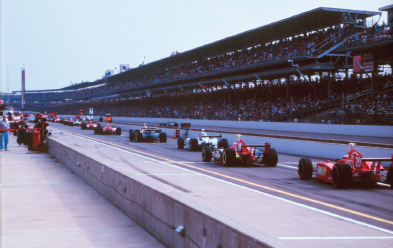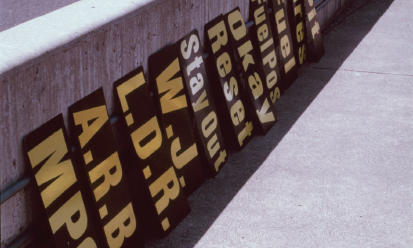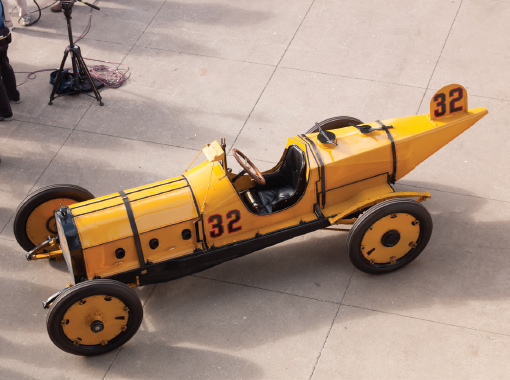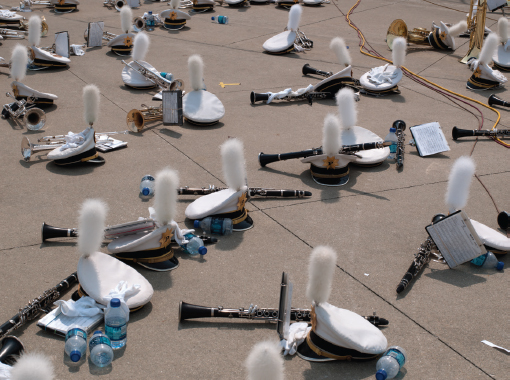
INTRODUCTION




THE INDIANAPOLIS Motor Speedway has been the premier venue for auto testing and racing for one hundred years. Its longevity has been assured by man’s fascination with both technology and speed.
In 1909 the term “horseless carriage” had a derisive ring to it. As the automotive age got “up to speed” (so to speak) the concept of “horsepower” was no longer a laughing matter.
The two-and-a-half-mile track at Indianapolis was born of a need for tinkerers, inventors, and other pioneering auto “manufacturers” to “torture test” their creations. The first official 500-mile race took place in 1911. There was little consistency among the cars that entered that race, save the fact that each had four wheels and an internal combustion engine. It was a noisy, smoky, oily, and deadly spectacle. The majority of the forty cars that started the race were from the United States, but the event billed as The International 500 Mile Sweepstakes Race truly was international. There were cars and drivers from France, Italy, the UK, and Switzerland. The family name of the Swiss driver would go on to be famous around the world: he was Arthur Chevrolet. A look at the names of the car models and their manufacturers that entered that first race indicates where the nascent automobile industry was coming from and where it would be headed. The entry card bears names such as Mercedes, Stutz, Fiat, Benz, and Firestone-Columbus (the entrant’s official name was the Columbus Buggy Company). Several cars bore the name “Case.” This was a rare foray into automobile manufacturing for the company that began in 1844 as the J. I. Case Threshing Machine Company. Case would go on to become a giant in the production of tractors and other agriculture and construction equipment. The engine that they raced at Indy was an experimental design that burned “oil.”
The first “500” set the standard as the race to showcase the best driver in the best car, with “up to the minute” technology. The Speedway to this day proves to be a “laboratory” for automotive and racing innovation. You could say the 1911 race was won as a result of a breakthrough innovation. In those early years it was customary to race with two men in each car—the driver and a “riding mechanic.” On some cars this mechanic would operate a lever to pump lubricating oil through the engine (automatic oil pumps were not yet in general use). He would also function as an on-board “spotter” to keep the driver aware of surrounding traffic.
Ray Haroun was entered in a US-made Marmon “Wasp” race car. In the interest of saving weight he was alone in the cockpit. His team had rigged what would become an automotive standard—a rearview mirror. It was the first such recorded use. Haroun would win the race—and the winner’s purse of $10,000.
The initial 500-mile race in 1911 also saw the first of many Indy fatalities. About twenty-five miles into the race, the car driven by Arthur Greiner lost a front wheel and crashed during the second turn. The driver and riding mechanic were thrown from the car. Initial reports said that riding mechanic Sam Dickson was “killed instantly,” a fact that has come into question. The crowd swarmed around both Greiner and Dickson. The state militiamen who were charged with security at the racetrack had to use their guns as clubs in order to clear a path for the medical attendants. In the “show must go on” tradition, the track debris was cleared and the race was resumed.

The Marmon Wasp, the winning racer at the first Indianapolis 500.
In looking at a century of racing at Indianapolis, there are decades where nothing changes very much. Then, a single innovation—the rear engine, the aerodynamic “wing,” or innovative tire composition—can revolutionize the sport. It causes the teams to scrap the equipment they were using and experiment with the new. A team with sponsors with “deep pockets” can become quite innovative. Some little trick that saves a half second on each lap—well, there are 200 laps in the 500-mile race.
Over a span of twelve years I visited the Speedway eight times for the race weekend—a Memorial Day tradition. Veterans, past and present, are honored each year. There is always some grand “showing of the flag” on the apron of “pit lane” prior to the race. Indy knows how to make those in the armed forces feel appreciated.
The venue is huge. The racetrack is a “squared oval,” two-and-a half miles around. The “infield” is an anthill of distinct neighborhoods: first and foremost is Gasoline Alley. This is where qualifying teams garage, service, repair, and show off the cars they are preparing and are tweaking into “race trim.” The fan (with the right access pass) gets a very close-up look at his or her heroes and their machines. There are “perks” for the top-ranked teams. The garage’s proximity to the track entrance is based on a “points” system. Aside from “location,” there is a neat consistency to all the garages. The teams roll in all of the tools and parts that they need for racing. When they leave, it’s a blank slate for the next race.
Each of my early visits to the Indy 500 would end with the knowledge that more “coverage” would be needed before weaving it into the desired book. After four or five additional sessions at additional 500s, change was complicating matters.
Initially a team would go with Chevy, Toyota, or Honda for an “engine package.” They also made a choice for “chassis”—either Panoz-G Force or Dallara. This is basically the whole race car, less the aforementioned engine. Everyone has Firestone tires. Everyone has an Xtrac transmission. Then the “automobile crisis” happened!


The marching band will return shortly.
Chevy stopped racing (GM was in big trouble). Toyota didn’t come to America just to compete against another Japanese engine, so they dropped out.
Honda, heroically, “stayed the course.” They were the supplier of engines to every team. A Honda executive quipped, “Yes, we’re sure to win the Indianapolis 500, but we also know we’ll come in last.”
Drivers changed teams. Drivers retired. Drivers died. Drivers tried NASCAR. Drivers lost their “ride.” Sponsors, peripheral equipment, and rules all changed.
The severe pangs in the world economy put pressures of change on the Speedway and Indy racing in general. Gradually it became clear that this was not a tight linear story; this is about change.
***
The photographs here were collected between 2003 and 2015. I began with the notion that covering the great Indy 500 race for a few years would yield material that was worthy of publication. Like all true documentaries, once begun, the artist finds himself merely “along for the ride.”
Early enthusiasm moved me to follow the teams that had competed in the 500 to a few other venues in the Indy Racing League season. I made trips to Chicagoland in Illinois, California Speedway in Fontana (now known as Auto Club Speedway), Phoenix International Raceway in Arizona, Texas Motor Speedway in Ft. Worth, and Nazareth Speedway in Pennsylvania. These subsequent races provided me with valuable access to the cars, the teams, and the racing life. For five consecutive years I returned to Indy. Following each of those trips I reshaped my portfolio and explored opportunities for publication. Personal and professional projects intervened and left some gaps in my coverage. For the record, the years covered are 2003, 2004, 2005, 2006, 2007, 2009, 2014, and 2015.
Finally, in early May of 2015, the project became a reality. The pictures shot at the ninety-ninth running of the Indianapolis 500, when added to all the previous images, brought the total to over seven thousand. The author appreciates the full spectrum of (living) Indy winners who gave time and effort to this project. A portrait of Indy emerges through their words and thoughts that no writer could fashion.
The changes, confusion, conflict, and chaos surrounding open-wheel racing during my purview has not diminished my fascination with this great American competition.

This gentleman came to the racetrack by jumping from a perfectly good aircraft.